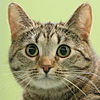German Rex
| German Rex | |
|---|---|
|
|
|
Default:
|
|
| body | The body is of medium size and length. It should be strong and muscular, but not massive or plump. The chest is rounded and strong in profile. The back is straight. The legs are comparatively fine and of medium length. The feet are well defined, suggesting an oval shape. |
| head | The head is rounded with good width between the ears, a strong chin and well developed cheeks. The nose has a slight indentation at the base. The eyes are at a good distance from the nose line, more outward than inward, and are of medium size, well open and round, of a bright color that should harmonize with the respective hair color.
The ears are medium-sized, broad at the base and slightly rounded at the tips. The outside is densely covered with fine hair, the inside is slightly hairy. |
| tail | The tail is medium in length. Slightly tapering from a middle approach to a rounded tip. With good hair, it must be without any defect in the bone structure. |
| hide | All coat colors are allowed (white). The highest number of points is awarded for coat quality. |
| List of cat breeds | |
German Rex is a domestic cat breed .
features
A breed-forming characteristic is the curly or wavy fur, which is velvety soft to the touch like a mole's fur. The guard hairs are underdeveloped and the guide hairs are missing. The whiskers are shortened and curved. The figure of the German Rex is medium-sized and strong, but not plump. It has a rounded head with strong cheeks and a slight indentation at the base of the nose. Their eyes are medium-sized and round, their ears have rounded tips, and their legs are relatively delicate with oval paws. Their overall appearance corresponds to a slim house cat .
hide
The Rex fur is different from the normal fur and the essential characteristic of the German Rex. Due to the lack of awn hair , the fur feels soft and velvety like a mole's fur. It's softer than that of the Devon Rex . The coat is short and plush-like, with a clear tendency towards waviness or curls. The development of curls is often not completed until the age of two. This must be taken into account with young animals. The whiskers are slightly shorter than normal and slightly curved. The basis for the curly coat is a defect mutation in hair growth and is inherited as an autosomal recessive trait. It is identical to the mutation that gave the Cornish Rex cat its curly fur.
history
As the oldest Rex cat breed, a photo from 1930 or 1931 shows the blue-gray male Munk as a representative of this breed, who lived in Königsberg .
The first Rex cats that we know of in Western Europe are not the result of targeted breeding , but owe their discovery to a coincidence. In 1950, the cat breeder Nina Emismore in Cornwall , England discovered a kitten with a fur that resembled that of the Rex rabbit in the litter of a tree-less shorthair cat . It was plush and wavy. The whiskers and eyebrows were puckered too. The cause for this was a mutation . The owner called the animal the Rex cat. It became the ancestral mother of a new breed.
Tribe and breeding
The ancestral mother of today's German Rex cats is Lammchen , a curly-haired cat who has been around the Hufelandklinik in Berlin-Buch since around 1947. In 1951, the doctor Dr. Rose Scheuer-Karpin the cat and took it with her. In 1957 Lammchen gave birth to curly offspring for the first time, the father was Lammchen's son, the smooth-haired Fridolin . With Blackie II , also one of her sons, she sired the Rex cats Curlie , Christopher Columbus and Marko Polo . Only Curlie stayed in what was then the GDR, Marko Polo was sent to France and Christopher Columbus came to the USA, where he brought his genetic makeup into the Rex cat breed.
When Lämmchen died in 1967 (another source cites December 19, 1964), she had only three curly offspring in East Berlin: Brutus came to Beatrice and Jeannette vom Grund in the kennel "vom Grund" of the Barensfeld family. With the hybrid Bonifatius they established the basis for the further development of the breed. In West Germany, the Wöllner family, cattery "von Zeitz", became involved in German Rex breeding in 1973.
Individual evidence
- ↑ German Rex cats - character and history. Retrieved July 23, 2019 .
